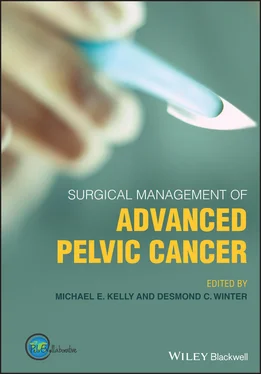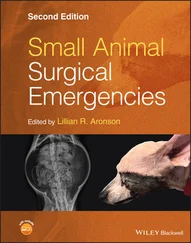1 Cover
2 Title Page
3 Copyright Page
4 List of Contributors
5 Preface
6 1 From Early Pioneers to the PelvEx Collaborative Background The Pioneers Future Directions References
7 2 The Role of the Multidisciplinary Team in the Management of Locally Advanced and Recurrent Rectal Cancer Background Complex Pelvic Cancer MDTM Staging, Restaging, and Pathological Assessment Complex Cancer MDTM Outcomes References
8 3 Preoperative Assessment of Tumor Anatomy and Surgical Resectability Background Cancer Anatomy and Resectability Radiological Assessment of Cancer Anatomy by MRI Case Study Radiological Assessment of Metastatic Disease References
9 4 Neoadjuvant Therapy Options for Advanced Rectal Cancer Background Potential Advantages of TNT Potential Disadvantages of TNT Short‐Term Outcomes Long‐Term Oncological Outcomes Organ Preservation Chemotherapy and Compliance Novel Chemotherapeutic Agents Immunotherapeutics Locally Recurrent Rectal Cancer Future Developments References
10 5 Preoperative Optimization Prior to Exenteration Background Clinical Examination Laboratory Tests Risk Assessment of Morbidity and Mortality Preoperative Optimization Mechanical Bowel Preparation and Oral Antibiotic Prophylaxis Thromboprophylaxis Stoma Education References
11 6 Patient Positioning and Surgical Technology Background Operating Room Setup Patient Positioning Surgical Equipment and Energy Devices References
12 7 Intraoperative Assessment of Resectability and Operative Strategy Background The Preoperative Phase The Intraoperative Stage References
13 8 Anterior Pelvic Exenteration Background Diagnostics Specific to Anterior Pelvic Exenteration Surgical Procedure Morbidity and Mortality References
14 9 Posterior Pelvic Exenteration Background Preoperative Assessment Intraoperative Decision‐Making References
15 10 Total Pelvic Exenteration Background Indications Who Should Be Performing these Procedures? Selecting the Right Team and Plan Neoadjuvant Therapy Surgical Technique References
16 11 Extended Exenterative Resections Involving Bone Background Anatomical Considerations Patient Workup Specific to Bony Resection Neoadjuvant treatment Operative Technique Novel Approaches in Sacrectomy Outcomes References
17 12 Exenterative Resections Involving Vascular and Pelvic Sidewall Structures Background Anatomy Preoperative Evaluation Intraoperative Management Postoperative Management References
18 13 Extended Exenterative Resections for Recurrent Neoplasm Background Strategies for Tackling Involvement of Posterior Compartment Including Sacrum Strategies for Tackling Involvement of Pelvic Sidewall Strategies for Tackling Involvement of Anterior Compartment References
19 14 Pelvic Exenteration in the Setting of Peritoneal Disease Background Treatment Options of Colorectal Peritoneal Metastases Pelvic Exenteration, Cytoreductive Surgery, and HIPEC References
20 15 Minimally Invasive Pelvic Exenteration Background History of Minimally Invasive Pelvic Exenterative Surgery Advantages of a Robotic Approach to Exenteration Surgical Planning and Reconstruction Robotic Surgical Approach Outcomes Future Directions References
21 16 Stoma Considerations Following Exenteration Background Urinary Diversion Incontinent Urinary Diversions Continent Urinary Diversions Comparison of Continent and Incontinent Urinary Diversions Urological Leaks Fecal Diversion Combined Fecal and Urinary Diversion Parastomal Hernia Future Developments References
22 17 Reconstructive Techniques Following Pelvic Exenteration Background Bowel Reconstruction Urinary Tract Reconstruction Reconstruction of Perineum References
23 18 Minimizing Morbidity from Pelvic Exenteration Background Knowing the Risks Intraoperative Management Postoperative Management Postoperative Complications References
24 19 Crisis Management Background Prior to Surgery Intraoperative Management Postoperative Management References
25 20 Quality of Life and Patient‐Reported Outcome Measures Following Pelvic Exenteration Background Quality of Life and Patient‐Reported Outcomes Instruments Quality of Life Trajectories Following Pelvic Exenteration Predictors of Postoperative Quality of Life Patient‐Reported Outcome Measures Following Pelvic Exenteration Future Directions References
26 21 Adjuvant Therapy options after Pelvic Exenteration for Advanced Rectal Cancer Background Adjuvant Therapy Novel Agents Radiotherapy Future Directions References
27 22 Adjuvant Therapy Options after Pelvic Exenteration for Gynecological Malignancy Background Cervical Cancer Vaginal Cancer Vulval Cancer Endometrial Cancer Ovarian Cancer References
28 23 Adjuvant Therapy Options for Urological Neoplasms Background Prostate Cancer Bladder Cancer Conclusion References
29 24 The Role of Re‐irradiation for Locally Recurrent Rectal Cancer Background Treatment of Locally Recurrent Rectal Cancer Morbidity After Re‐irradiation Primary Outcome after Re‐irradiation for LRRC References
30 25 Palliative Pelvic Exenteration Background Historical Perspective Definition Indications Outcomes Future Directions References
31 26 Outcomes of Pelvic Exenteration for Locally Advanced and Recurrent Rectal Cancer Background Tumor Biology and its Effect on Oncological Outcomes Oncological Outcomes and Radiation Therapy Outcomes of the Largest Pelvic Exenteration Series in the Literature Mortality and Morbidity References
32 27 Outcomes Following Exenteration for Urological Neoplasms Background Prostate Cancer Bladder Cancer Complications Palliative Exenterations Quality of Life References
33 28 Outcomes Following Exenteration for Gynecological Neoplasms Background Further Important Situations Preoperative Workup Specific to Gynecological Neoplasms Preoperative Planning and Counseling Complications Survival and Quality of Life References
34 29 Mesenchymal and Non‐Epithelial Tumors of the Pelvis Background Incidence Etiology Specific Diagnostics Treatment Benign Soft Tissue Tumors of the Pelvis Soft Tissue Sarcomas of the Pelvis Benign Bone Tumors Involving the Pelvis Malignant Bone Tumors of the Pelvis References
35 Index
36 End User License Agreement
1 Chapter 2 Table 2.1 Differences between hospitals caring for “regular” colorectal canc...
2 Chapter 3 Table 3.1 Existing classification systems for pelvic compartments. Table 3.2 The St. Mark’s roadmap approach for assessment of pelvic tumor ana... Table 3.3 Construction of the roadmap for R0 resection in patient 1.
3 Chapter 5 Table 5.1 Nutritional Risk Screening (based on NRS‐2002) [4].
4 Chapter 7Table 7.1 Checkpoints for proceeding at the intraoperative stage.Table 7.2 Planes of unexpected tumor extension and potential strategies for...
5 Chapter 8Table 8.1 Complications after anterior pelvic exenteration.
6 Chapter 9Table 9.1 Pelvic and abdominal organs to be removed during posterior pelvic ...Table 9.2 Postoperative complications after posterior pelvic exenteration (n...Table 9.3 Prognosis after posterior pelvic exenteration.
7 Chapter 10Table 10.1 Contraindications for TPE.
8 Chapter 11Table 11.1 Bony exenteration: indications and contraindications.Table 11.2 Series of en‐bloc sacrectomy for recurrent rectal adenocarcinoma...
9 Chapter 18Table 18.1 Surgical checklist for pelvic exenteration.
10 Chapter 20Table 20.1 Common quality of life (QoL) instruments and other health‐relate...Table 20.2 Evidence of quality of life (QoL) following pelvic exenteration.
11 Chapter 21Table 21.1 Landmark studies of adjuvant chemotherapy in rectal cancer after...Table 21.2 Ongoing clinical trials of immune checkpoint inhibitors in locor...
12 Chapter 24Table 24.1 Patient and previous radiotherapy characteristics.Table 24.2 Re‐irradiation details and outcome.
Читать дальше












